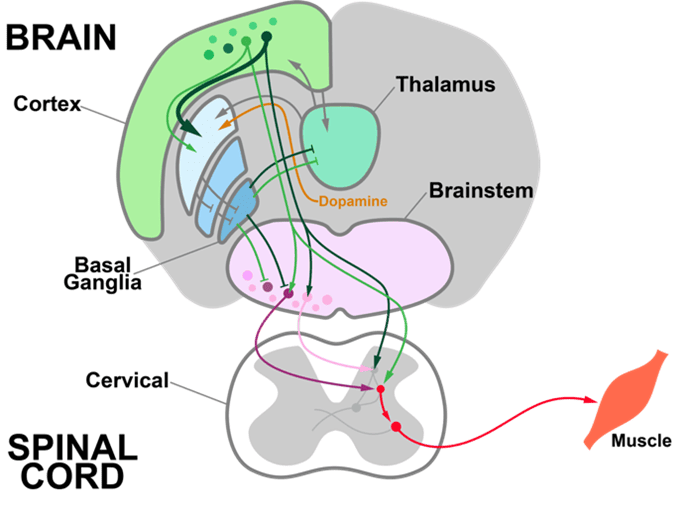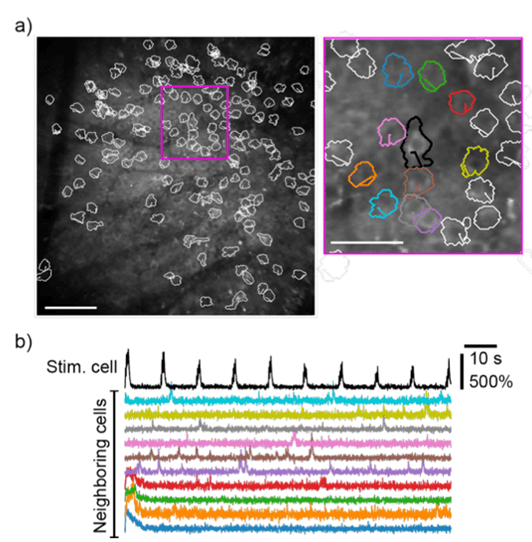Throughout our lives, we learn a range of actions that enable us to interact with and influence the environment around us, thereby achieving desired outcomes. Proper initiation, selection, and execution of these behaviors is essential for adaptation and survival.
Over the past decades, there has been a substantial increase in the mechanistic understanding of how particular movements and behaviors are generated, learned, and selected. Overt behavior is generated through the activity of muscles, and one of the challenges in understanding behavior has been to understand the logic of muscle innervation, from the brain to motor units, and to uncover how these neural circuits precisely interact to control muscles and produce behavior.
We are developing and using genetic, electrophysiological, optical, and behavioral approaches to investigate how the brain adaptively controls behavior. The team focuses on understanding the descending circuits that control the execution of actions and how they change when actions are reinforced and refined.

Motor observatory
A better understanding of motor function and control can only be addressed when we have comprehensive characterization of behavioral 3D kinematics. This will be the first step in dissecting how neuronal activity controls precise muscle coordination during action generation.
To increase the behavior repertoire and capture a wide range of movements, we developed a behavioral set-up with several types of enrichment, such as climbing walls, ladders, and wheels. This set-up is surrounded by multiple cameras, allowing for robust capture of movements from numerous angles, including hand/digit tracking and avoidance of occlusions. We are using computer vision advances in unsupervised 3D pose estimation and temporal propagation to build an efficient 3D tracking pipeline with significantly less manual annotation needs. This analysis pipeline will be widely available for the scientific community studying behavioral analysis.
To further facilitate keypoint annotation, we have also developed Anivia, a new annotation web tool derived from VGG Image Annotator. Among other features, this allows for point triangulation and projection to other views, and it color codes points depending on their reprojection error across views.
3D kinematics will be combined with recorded EMG signals using high-density electrode arrays developed by collaborators in Emory University and Georgia Institute of Technology. These allow for recordings of single motor units from different muscle groups simultaneously. These recordings will help us dissect the relationship between motor unit activity and kinematics and provide insight for future motor control experimental design.
Dissecting descending neural circuits of motor control
Precise 3D kinematics and muscle activity of behaving mice will allow us to better understand how neuronal activity controls precise muscle coordination. To expand our understanding of the functional connection between motor circuits, we need to better understand the logical innervation and signal transformation between brain regions involved in motor control, spinal cord, muscle activity. To achieve this, we are focusing on:
- Developing behavior paradigms with precise control of action features, while incorporating 3D kinematic tracking and muscle activity recordings, to better quantify motor output.
- Leveraging 1-photon and 2-photontechnology to record single-cell neural activity of precise neuronal subtypes during behavior.
- Optimizing optical methods to stimulate precise neural ensembles modulating specific self-paced actions (holographic stimulation), rather than general genetically targeted subpopulations.
- Integrating optical and electrophysiological methods to simultaneously record neuronal activity from multiple areas along the descending axis of motor control, including the brain, spinal cord, and muscles.
- Combining 1-4 to characterize how stimulation of precise neuronal ensembles changes activity in downstream circuits, and ultimately leads to changes in kinematics, muscle activity, and behavior.

Characterize learning and motor deficits associated with Parkinson’s disease
Parkinson’s disease (PD) is a slow, progressive disorder characterized by a loss of dopaminergic neurons and accompanying motor dysfunction. Of key importance to disease progression is the question of how different basal ganglia circuitry is altered during disease progression.
In a recent pre-print publication, we used single-nucleus RNA-sequencing to identify a dopaminergic subpopulation that is particularly vulnerable during disease progression, the Anxa1+ neuronal subset. We have also done precise behavior measures using video and wireless motion sensor recordings, allowing us to track progressive changes in bradykinesia, akinesia and tremor-like emergence.
We will leverage previous data to analyze EMG and behavioral kinematic changes with progressive dopamine loss. We will use 1-photon imaging with single cell resolution to understand how striatal and SNr circuitries are progressively remodeled during disease progression, and how dopamine activity influences behavioral expression.
This work is supported by grants from the Aligning Science Across Parkinson's (ASAP-020551& ASAP-025185) through the Michael J. Fox Foundation for Parkinson’s Research (MJFF).
OpenScope Steering Committee
The OpenScope Steering Committee convenes at least biannually to provide crucial direction for the OpenScope project, playing an essential role in ensuring that we effectively serve our broader community.

















